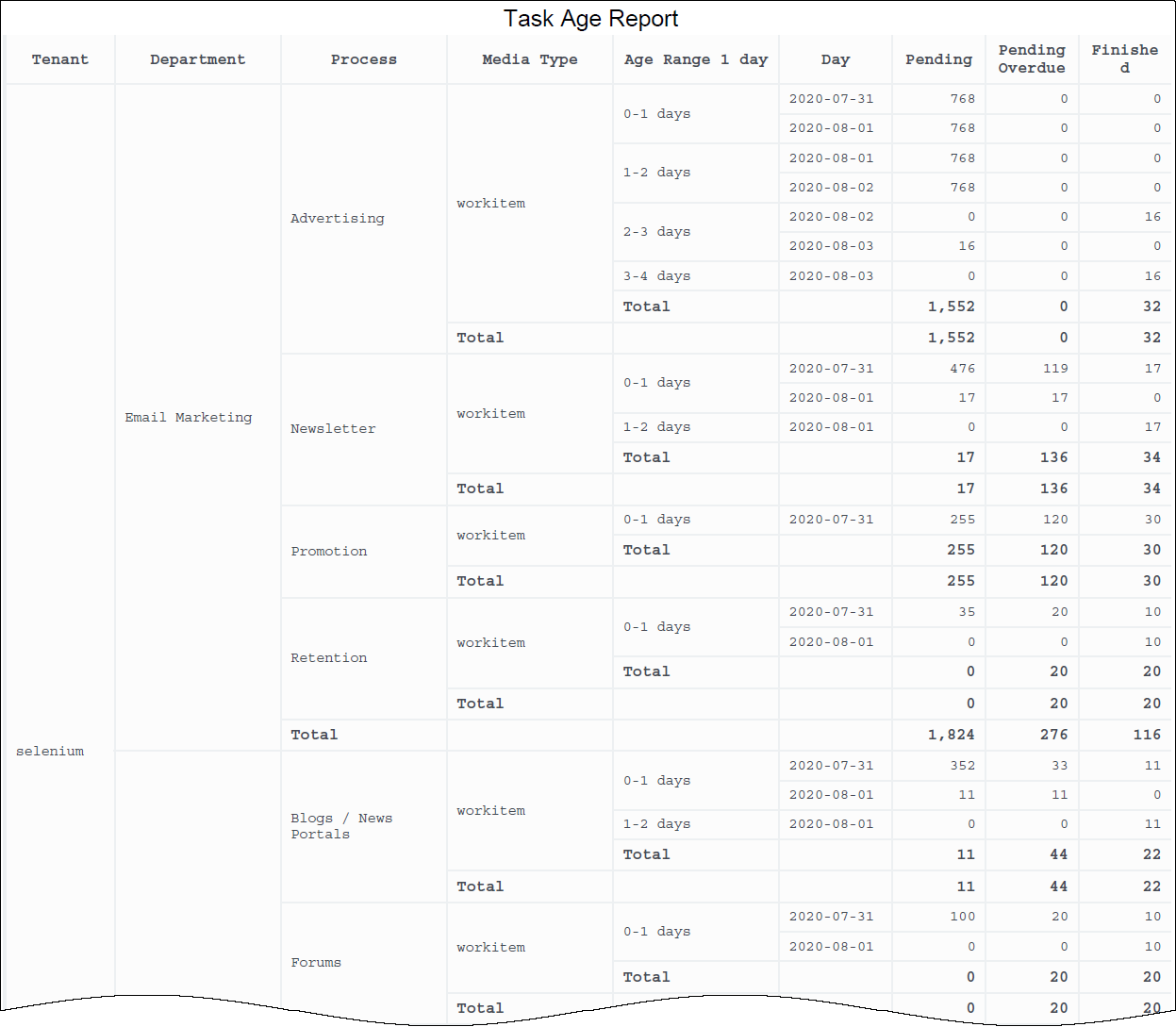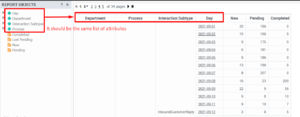Contents
Task Age Report
Use the (CX Insights for iWD folder) > Task Age Report to better understand how well each department and process is meeting Service Level Agreements. This report provides detailed information about the volume of tasks that are handled within the defined Service Level interval, and the volume that breach the Service Level Agreement for departments and processes.
Understanding the Task Age Report
This report provides detailed information about the volume of tasks that are handled within the defined Service Level interval, and the volume that breach the Service Level Agreement for departments and processes.
To get a better idea of what this report looks like, view sample output from the report:
SampleTaskAgeReport.pdf
The following tables explain the prompts you can select when you generate the report, and the metrics and attributes that are represented in the report:
Prompts in the Task Age Report
| Prompt | Description |
|---|---|
| Pre-set Day Filter | Choose from the convenient list of predefined rolling time ranges, spanning one day or more, over which to run the report. |
| Start Date | Choose the first day from which to gather report data. |
| End Date | Choose the last day from which to gather report data. |
| Department | Optionally, select a department on which to focus the report. |
| Process | Optionally, select a business process on which to focus the report. |
| Media Type | Optionally, select one or more media types for which to gather data into the report. |
Attributes in the Task Age Report
| Attribute | Description |
|---|---|
| Department | Enables data within the reporting interval to be organized by the name of the department for which iWD prioritizes and routes tasks. |
| Process | Enables data within the reporting interval to be organized by the name of the business process, which is a core attribute of tasks and work items that define strategies for how to route them. |
| Media Type | Enables data to be organized by media type. |
| Age Range 1 day | Enables data within the reporting interval to be organized by the age of the task, where age has a granularity of exactly 1 day ranges. The attribute contains non-overlapping ranges like 0-1 day, 1-2 day, 3-4 day, and so on. For information about customization, see Customizing the dashboard. |
| Day | Enables data within the reporting interval to be organized by a particular day within a month and year. Day values are presented in YYYY-MM-DD format. |
Metrics in the Task Age Report
| Metric | Description |
|---|---|
| Pending | The current number of tasks that were pending (where the task status is Queued, Assigned, or Held) at the end of the reporting interval. |
| Pending Overdue | The current number of pending tasks that were overdue at the end of the reporting interval. A task is considered overdue when the SLA due date/time has been missed. |
| Finished | The total number of tasks of this classification that were completed during the reporting interval. |
To view more detailed information about the metrics and attributes in this report, and other metrics and attributes that can be used to customize reports, see the Genesys CX Insights Projects Reference Guide.
Customizing the dashboard
Some dashboards contain attributes representing different granularity of an attribute, such as Age Range, or Business Value. You can change the granularity of the data shown on the dashboard by replacing this attribute with another; this procedure uses Business Value Range in the Capture Point Dashboard as an example (or see the video below).
Procedure: Changing the granularity of the dashboard data
Purpose: Change the Business Value Range. By default, the Capture Point Dashboard is configured to use the "Business Value Range 100" attribute.
Steps
- Log in with an account having Administrator privileges.
- Open and run the dashboard.
- Complete the following steps to make a copy of the dashboard, rather than modify the original:
- Click File > Save As.
- In the Save As editor:
- In the Save in list, choose one of the following paths:
- Shared Reports > Custom — to make the modified dashboard accessible to other users.
- My Reports — to make the modified dashboard accessible only to you.
- Enter a Name for the report, and optionally modify the Description, or Advanced Options.
- Click OK.
- In the Save in list, choose one of the following paths:
- In the Dossier Saved editor, click Run newly saved dossier.
- You can now modify the dashboard:
- From the View menu, click Datasets Panel.
- The Datasets Panel appears, where you can select a new Business Value Range to apply.
- Right-click the existing attribute value (Business Value Range 100 by default), and in the menu that appears, choose Replace Reference With.
- Click the name of the dataset object to insert (for example Business Value Range 1000).
- The selected dataset attribute replaces the default Business Value Range 100 attribute.
- From the View menu, click Datasets Panel.
- Click File > Save to save your changes, and rerun the report to verify the results.
Video: Changing the granularity of the dashboard data
This video describes how to customize the Business Value Range.
Customizing attributes
If you customize this report, you must ensure that the attributes listed in "REPORT OBJECTS" matches the attributes used in the report grid, as shown in the figure Ensure that the attributes in the grid match those in the REPORT OBJECTS list'.
This means that:
- To remove an attribute from the report, you must do so by clicking Remove from Report, (not Remove from Grid).
- To add a new attribute, you must add it both to the REPORT OBJECTS list, and to the report grid.
If you do not follow these steps, the totals for the Pending\Pending Overdue metrics may be displayed incorrectly.



